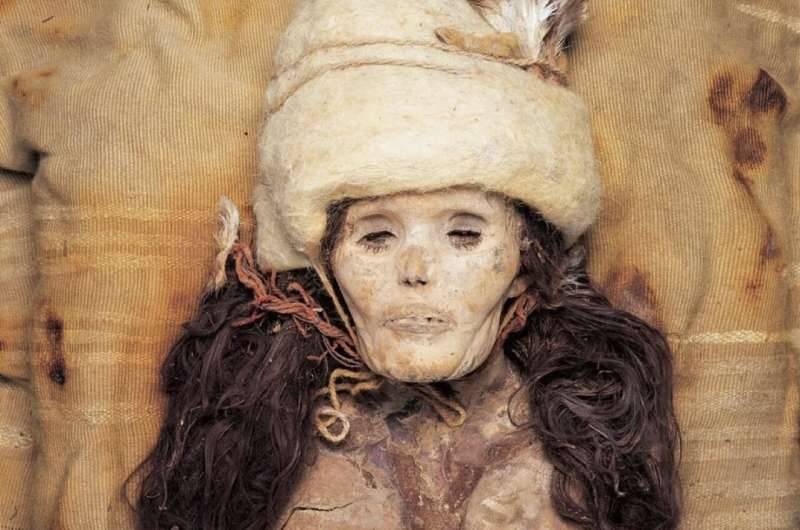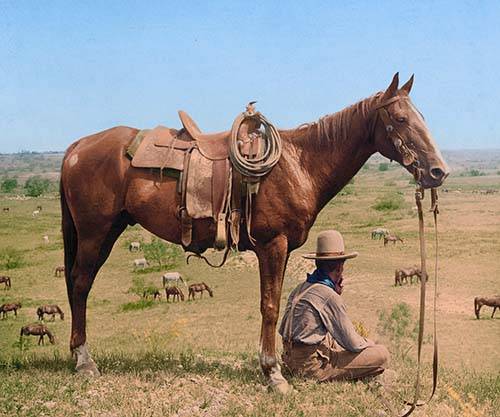As part of the Silk Road and located at the geographical intersection of Eastern and Western cultures, the Xinjiang Uyghur Autonomous Region has long served as a major crossroads for trans-Eurasian exchanges of people, cultures, agriculture, and languages. Since the late 1990s, the discovery of hundreds of naturally mummified human remains dating to circa 2,000 BCE to 200 CE in the regions Tarim Basin has attracted international attention due to their so-called Western physical appearance, their felted and woven woolen clothing, and their agropastoral economy that included cattle, sheep and goat, wheat, barley, millet, and even kefir cheese. Buried in boat coffins in an otherwise barren desert, the Tarim Basin mummies have long puzzled scientists and inspired numerous theories as to their enigmatic origins.
The Tarim Basin mummies cattle-focused economy and unusual physical appearance had led some scholars to speculate that they were the descendants of migrating Yamnaya herders, a highly mobile Bronze Age society from the steppes of the Black Sea region of southern Russia. Others have placed their origins among the Central Asian desert oasis cultures of the Bactria-Margiana Archaeological Complex (BMAC), a group with strong genetic ties to early farmers on the Iranian Plateau.
To better understand the origin of the Tarim Basin mummies founding population, who first settled the region at sites such as Xiaohe and Gumugou circa 2,000 BCE, a team of international researchers from Jilin University, the Institute of Vertebrate Paleontology and Paleoanthropology, the Max Planck Institute for Evolutionary Anthropology, Seoul National University of Korea, and Harvard University generated and analyzed genome-wide data from thirteen of the earliest known Tarim Basin mummies, dating to circa 2,100 to 1,700 BCE, together with five individuals dating to circa 3,000 to 2,800 BCE in the neighboring Dzungarian Basin. This is the first genomic-scale study of prehistoric populations in the Xinjiang Uyghur Autonomous Region, and it includes the earliest yet discovered human remains from the region.
Aerial view of the Xiaohe cemetery. Credit: Wenying Li, Xinjiang Institute of Cultural Relics and Archaeology
The Tarim Basin mummies were not newcomers to the region
To their great surprise, the researchers found that the Tarim Basin mummies were not newcomers to the region at all, but rather appear to be direct descendants of a once widespread Pleistocene population that had largely disappeared by the end of the last Ice Age. This population, known as the Ancient North Eurasians (ANE), survives only fractionally in the genomes of present-day populations, with Indigenous populations in Siberia and the Americas having the highest known proportions, at about 40 percent. In contrast to populations today, the Tarim Basin mummies show no evidence of admixture with any other Holocene groups, forming instead a previously unknown genetic isolate that likely underwent an extreme and prolonged genetic bottleneck prior to settling the Tarim Basin.
Archaeogeneticists have long searched for Holocene ANE populations in order to better understand the genetic history of Inner Eurasia. We have found one in the most unexpected place, says Choongwon Jeong, a senior author of the study and a professor of Biological Sciences at Seoul National University.
A profile view of the burial M13 from the Xiaohe cemetery. Credit: Wenying Li, Xinjiang Institute of Cultural Relics and Archaeology
In contrast to the Tarim Basin, the earliest inhabitants of the neighboring Dzungarian Basin descended not only from local populations but also from Western steppe herders, namely the Afanasievo, a pastoralist group with strong genetic links to the Early Bronze Age Yamanya. The genetic characterization of the Early Bronze Age Dzungarians also helped to clarify the ancestry of other pastoralist groups known as the Chemurchek, who later spread northwards to the Altai mountains and into Mongolia. Chemurchek groups appear to be the descendants of Early Bronze Age Dzungarians and Central Asian groups the from Inner Asian Mountain Corridor (IAMC), who derive their ancestry from both local populations and BMAC agropastoralists.
These findings add to our understanding of the eastward dispersal of Yamnaya ancestry and the scenarios under which admixture occurred when they first met the populations of Inner Asia, says Chao Ning, co-lead author the study and a professor of School of Archaeology and Museology at Peking University.
Excavation of burial M75 at the Xiaohe cemetery. Credit: Wenying Li, Xinjiang Institute of Cultural Relics and Archaeology
The Tarim Basin groups were genetically but not culturally isolated
These findings of extensive genetic mixing all around the Tarim Basin throughout the Bronze Age make it all the more remarkable that the Tarim Basin mummies exhibited no evidence of genetic admixture at all. Nevertheless, while the Tarim Basin groups were genetically isolated, they were not culturally isolated. Proteomic analysis of their dental calculus confirmed that cattle, sheep, and goat dairying was already practiced by the founding population, and that they were well aware of the different cultures, cuisines, and technologies all around them.
Despite being genetically isolated, the Bronze Age peoples of the Tarim Basin were remarkably culturally cosmopolitan—they built their cuisine around wheat and dairy from the West Asia, millet from East Asia, and medicinal plants like Ephedra from Central Asia, says Christina Warinner, a senior author of the study, a professor of Anthropology at Harvard University, and a research group leader at the Max Planck Institute for Evolutionary Anthropology in Leipzig, Germany.
Typical Xiaohe boat coffin with oar. The coffin is covered with a cattle hide. Credit: Wenying Li, Xinjiang Institute of Cultural Relics and Archaeology
Reconstructing the origins of the Tarim Basin mummies has had a transformative effect on our understanding of the region, and we will continue the study of ancient human genomes in other eras to gain a deeper understanding of the human migration history in the Eurasian steppes, adds Yinquiu Cui, a senior author of the study and professor in the School of Life Sciences at Jilin University.
SOURCE : Phys




